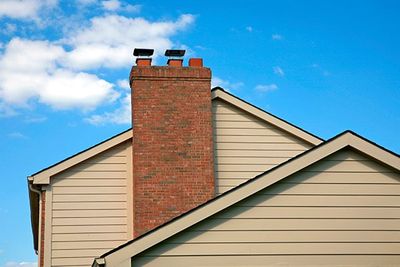FREQUENTLY ASKED QUESTIONS FROM SPRINGFIELD, VA
- Q: If I have a small crack in one of the panels in my fireplace, is this dangerous?
A: YES! A small crack in a fireplace panel can be a potential fire hazard. Sparks from a burning fire could escape into the surrounding areas of the firebox and cause a house fire. Simply patching the crack with a sealant will not restore the integrity of the original panel.
- Q: Why do I have a strong smoke smell in my home even when I am not burning a fire?
A: A strong odor of smoke may sometimes be caused by dampness in the flue, because of water leaking into the chimney. This could be due to a chimney not having a cap or due to cracks in the crown of the chimney. The smoke smell may also be due to the fact that the chimney has net been swept. A technician will be able to determine the cause upon an internal and external inspection of the chimney.
- Q: If I have been told that I have cracks in my chimney liner, can I still use the fireplace?
A: DEFINITELY NOT! The purpose of the chimney is not for decoration. The chimney is there to get rid of the dangerous gases and wood smoke from your home. It keeps the air inside your home safe to breathe. If the chimney does not function properly (because of cracks or gaps), these dangerous chemicals could lead to a house fire as well as carbon monoxide hazards.
- Q: Do I need a chimney cap?
A: Yes! The following items indicate the need for a chimney cap:
- Rain dripping into fireplace/bad smell after rain
- Animals inside the fireplace or flue
- Debris from trees, such as leaves
- Deteriorating mortar joints in the firebox due to rain/water damage
Have a certified chimney technician install a chimney cap so that you can be sure to get the proper size, clearance and safety. Don't waste your time and money by purchasing a low quality chimney cap that will need to be replaced again and again. Have our certified chimney technician install a high quality, stainless steel chimney or furnace flue cap that is guaranteed for life.
- Q: What is a chimney liner?
A: A chimney can be a fire waiting to happen. Hidden by the brick exterior, most chimneys contain a clay or terracotta liner that makes up the innermost membrane of the chimney and helps contain smoke, carbon monoxide, and burning embers produced by the home's fireplace or furnace. Some chimneys have no liner at all, just an aging brick shell.
Over time, the clay liner and brick can deteriorate, leaving the home vulnerable to carbon monoxide poisoning or fire. Harmful creosote, a flammable byproduct of burning wood, can build up on the inside of the chimney or liner and create the potential for chimney fires. Rebuilding the entire chimney liner is a one way to ensure a safer home, but it's also the costliest, and requires extensive demolition to the existing brick. Chimney relining systems are a less costly and less invasive solution.
Source: http://www.BobVila.com
- Q: What causes chimney fires?
A: Chimney fires are usually caused by the accumulation of creosote in the chimney. Creosote is a natural by-product of burning wood. It accumulates in the flue over time and is highly flammable. Creosote is especially likely to accumulate when wood is not burned at the proper temperature. Since creosote is flammable, when it accumulates on the walls of your flue, hot flue gasses can ignite it. The result is a chimney fire. Depending on the condition of your chimney, such a fire can pose a significant threat to the rest of your house. Flames from the fire can find their way through cracks in your clay chimney liner or mortar and ignite framing around the chimney. They can also spill over onto the roof and cause a fire there. Source: http://www.HomeSaverInfo.com
- Q: How often should I have my chimney cleaned?
A: The National Fire Protection Agency (NFPA) recommends a yearly inspection and cleaning and repairs done as necessary. Free standing wood stoves or fire place inserts used to heat the home should be inspected and cleaned if needed every year. Regular open fireplaces need to be maintained and cleaned on a consistent basis as well. Usually a cleaning is needed for every cord of wood burned or at least 2-3 years.
If you want more information call A-1 Chimney Sweep & Dryer Vent Service LLC at 703-296-7636.
CONTACT INFORMATION
Phone:
Address:
7785 Ballston Drive, Springfield, VA 22153
BUSINESS HOURS
- Mon - Fri
- -
- Saturday
- -
- Sunday
- Closed
By Appointment Only












